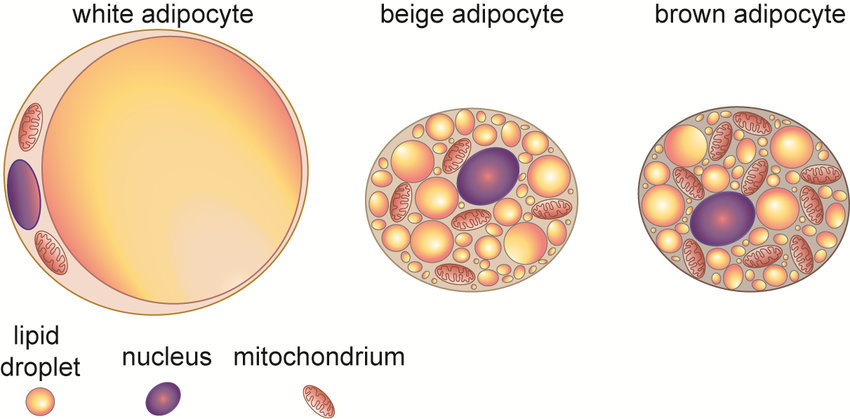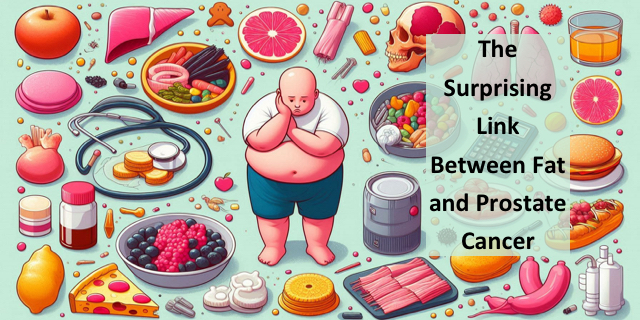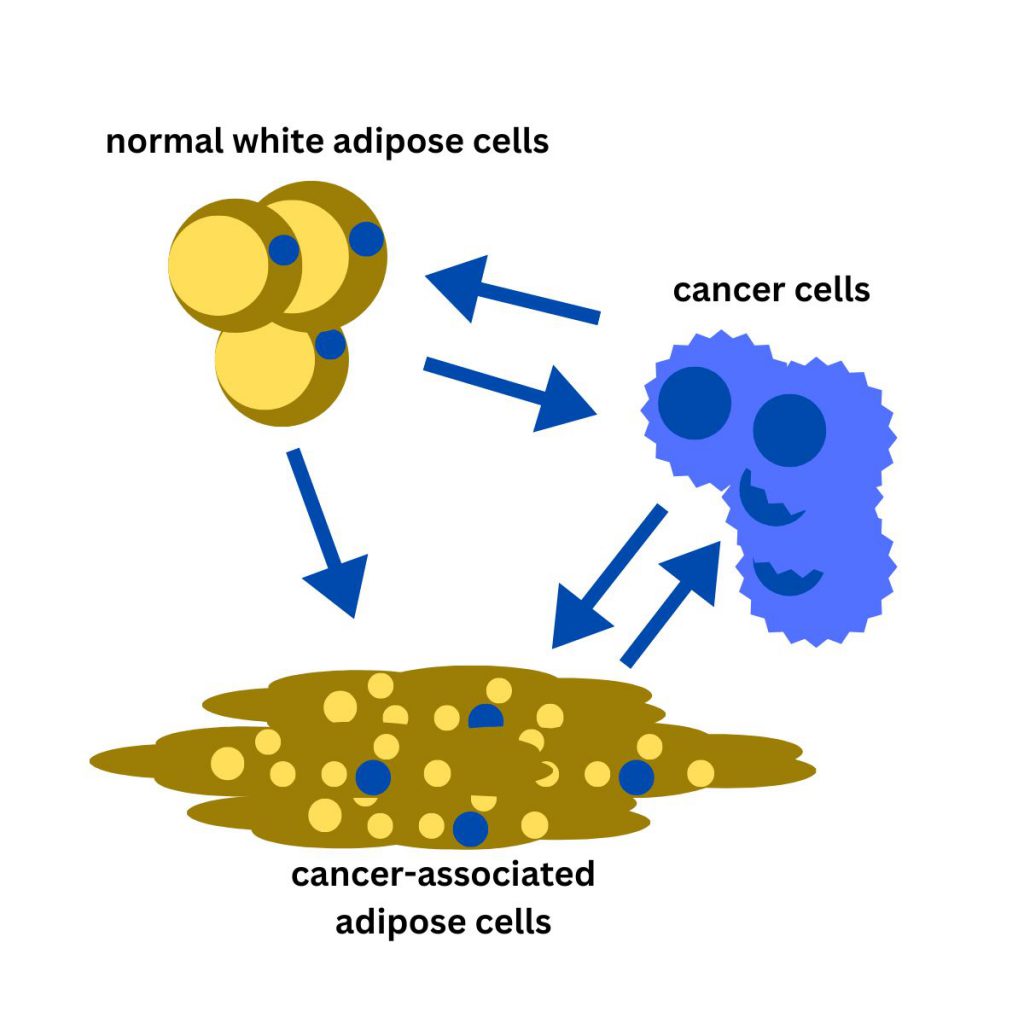Is there a link between fat and prostate cancer? A study published in April 2024 looked at 16,960 healthy men over a 22 year period (1994-2016). The research tracked their body mass index (BMI) and their health status. Over those 22 years, the men who were obese at the beginning of the study, and who then gained more weight over those years, were at higher risk for getting prostate cancer compared to others in the study. [1]
Strange coincidence? Or is there something important being uncovered about fat and prostate cancer here?
Fat or Adipose Tissue
Fat, or what is called in medical jargon adipose tissue, has been at the forefront of research in the last 20 years. We used to think of those love handles of adipose tissue as blobs of inactive cells that stored energy — in the form of fat or lipids — for our bodies. However, it has been discovered that adipose tissue is actually an organ (sort of like the discovery that the vascular endothelium is an organ). Adipose tissue is an endocrine organ. [2] Like your adrenal glands and your pancreas, adipose tissue secretes hormones and other chemicals. These hormones and “biologically active compounds,” (called adipokines) regulate quite an array of different activities in the body:
- coagulation (liquid blood forming into solid blood clots)
- appetite
- immunity
- how our body processes and metabolizes glucose and lipids
- reproduction (affecting the fertility of both women and men)
- growth of blood vessels (called angiogenesis)
- the breakdown of blood clots (fibrinolysis)
- body weight equilibrium or stability (homeostasis) and
- vascular tone control (adipose tissue secrete adipokines which are influence the action of nitric oxide and vascular endothelium ). [2]
Adipose cells secrete over 600 of these adipokines. [5]
Cross-talk and Stem Cells
In other words, what we thought we knew about fat or adipose tissue in the body has changed significantly. Adipose tissue communicates and signals other tissues and cells by secreting these chemicals and makes a lot of things happen in our bodies. It engages in “crosstalk with other tissues and organs, promoting blood vessel growth and interactions with the immune and nervous systems.”[3]
Not only that, adipose tissue contains stem cells. Stem cells are pluripotent, which means they are able to change into other types of cells and are able to divide and divide and divide (indefinitely) to make more cells like them. In the lab and in some clinical trials, researchers have learned that they can differentiate into many types of cells including bone and cartilage cells. [4]
There are three types of adipose tissue: white, brown and beige.

White adipose tissue is the most common in adults, making up 95% of an adults’ fat mass. [5] The cells of healthy white adipose tissue are round in shape, contain a small number of mitochondria and have one large lipid (fat) droplet.
So what do adipose cells have to do with cancer? Enter the tumor microenvironment…
The Tumor Microenvironment: Fat and Prostate Cancer Connection?
Though the term, tumor microenvironment, doesn’t have an agreed upon definition among scientists, there is an understanding that cancer cells create their own environment — their own secretions, metabolism and immunity — that is not regulated by the rest of the body. Adipocytes (adipose tissue cells) make up the tumor microenvironment as well as tumor cells., connective tissue cells, tiny blood vessels and more. [5]
Research has revealed that growing healthy adipose cells in the plasma from prostate cancer cells will cause an increase in the number of adipose cells grown (their proliferation) and make them behave more like stem cells.[3] Moreover, white adipocytes in the body that are just on the outside of cancer, exchange signals with the cancer cells. These adipocytes are called cancer-associated adipocytes. Like the ones grown in the petri dish lab, research shows they are changed by the cancer cells near them. These cancer-associated adipocytes look different from normal white adipocytes. Instead of being round, they become irregularly shaped, contain small lipid droplets and are smaller in volume. [5]
Fat Cells and Cancer Growth
As a tumor (cancer) grows, it often grows beyond its blood supply. This leads to a hypoxic environment (lacking oxygen). Adipose tissue helps cancer cells adapt to this hypoxic environment by releasing high energy compounds like free fatty acids that cancer cells use as a source of fuel for their spread and growth.[5, 6] In the body, the cancer-associated adipocytes also produce chemicals that promote growth and spread of tumor cells. As time passes, the cancer-associated adipose cells use their stem cell quality to change into connective tissue-like cells call cancer-associated fibroblasts. [5]
Cancer-associated Fibroblasts
One of the most abundant cells in cancers are the cancer-associated fibroblasts. Although they can come from a variety of cell types, evidence is accumulating that a portion of them come from adipose tissue. One of the features of these fibroblasts is their ability to help cancer cells change, like stem cells, from one cell type to another (epithelial–mesenchymal transition).[7]
Obesity and Inflammation
Additionally: for people who are obese, their adipose tissue secretes inflammatory chemicals because of the increased number and size of their adipocytes. This causes chronic inflammation both locally and systemically. [6] Chronic inflammation is also associated with cancer. [8]
Maintaining a Healthy Weight is a No-brainer
The prostate gland is surrounded by adipose tissue called periprostatic adipose tissue. Prostate cancer that infiltrates this adipose tissue is linked to poorer prognosis for cancer patients [7,9] — yet another reason to make sure your body’s adipose tissue is at a healthy level.
The thing about fat and prostate cancer is that prostate cancer isn’t the only type of cancer that has been linked to obesity. Research has been finding connections between excess adipose tissue and several different types of cancer in the body. That means, when it comes to your well-being, eating a healthy diet, exercising regularly, and maintaining a healthy weight may help stave off cancers, period.
- Støyten M, Knutsen T, Stikbakke E, Agledahl I, Wilsgaard T, Eggen AE, Richardsen E, Giovannucci E, Thune I, Haugnes HS. Excess weight, weight gain, and prostate cancer risk and prognosis: the PROCA-life study. Acta Oncol. 2024 Apr 9;63:154-163. doi: 10.2340/1651-226X.2024.32953. PMID: 38591351; PMCID: PMC11332472.
- Coelho M, Oliveira T, Fernandes R. Biochemistry of adipose tissue: an endocrine organ. Arch Med Sci. 2013 Apr 20;9(2):191-200. doi: 10.5114/aoms.2013.33181. Epub 2013 Feb 10. PMID: 23671428; PMCID: PMC3648822.
- Cruciani, S., Coradduzza, D., Balzano, F. et al. Modulation of adipose-derived stem cell behavior by prostate pathology-associated plasma: insights from in vitro exposure. Sci Rep 14, 14765 (2024). https://doi.org/10.1038/s41598-024-64625-0
- Tsuji W, Rubin JP, Marra KG. Adipose-derived stem cells: Implications in tissue regeneration. World J Stem Cells. 2014 Jul 26;6(3):312-21. doi: 10.4252/wjsc.v6.i3.312. PMID: 25126381; PMCID: PMC4131273.
- Yao, H., He, S.”Multi‑faceted role of cancer‑associated adipocytes in the tumor microenvironment (Review)”. Molecular Medicine Reports 24, no. 6 (2021): 866. https://doi.org/10.3892/mmr.2021.12506
- Song, Y., Na, H., Lee, S.E. et al. Dysfunctional adipocytes promote tumor progression through YAP/TAZ-dependent cancer-associated adipocyte transformation. Nat Commun 15, 4052 (2024). https://doi.org/10.1038/s41467-024-48179-3
- Su, F., Daquinag, A.C., Ahn, S. et al. Progression of prostate carcinoma is promoted by adipose stromal cell-secreted CXCL12 signaling in prostate epithelium. npj Precis. Onc. 5, 26 (2021). https://doi.org/10.1038/s41698-021-00160-9
- https://www.cancer.gov/about-cancer/causes-prevention/risk/chronic-inflammation#:~:text=Chronic%20inflammation%20may%20be%20caused,damage%20and%20lead%20to%20cancer.
- Cancel M, Pouillot W, Mahéo K, Fontaine A, Crottès D, Fromont G. Interplay between Prostate Cancer and Adipose Microenvironment: A Complex and Flexible Scenario. Int J Mol Sci. 2022 Sep 15;23(18):10762. doi: 10.3390/ijms231810762. PMID: 36142673; PMCID: PMC9500873.






